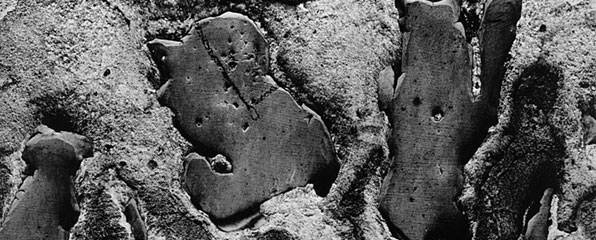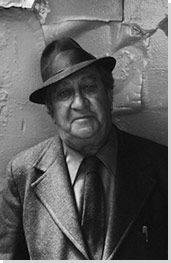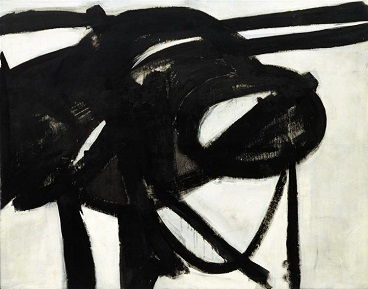Summary of Aaron Siskind
Aaron Siskind's early work as a social documentary photographer is best seen in his contributions to the Harlem Document (1932-40), a survey of life in Harlem. Siskind also identified with the ideas and styles of the Abstract Expressionist artists in New York in the 1940s. In these later photographs he continued to emphasize the modernist concern with the flatness of the picture plane, but intensified his approach to picture making - with close-up framing, as well as emphasis on texture, line, and visual rhymes - creating abstract images of the real world.
Accomplishments
- Siskind turned the medium of photography on its head, taking pictures of found objects that were simultaneously true-to-life and abstract; he was one of the first photographers to combine what was known as "straight" photography (recording the real world as the lens "sees" it) with abstraction.
- Siskind found emotional joy and tension in the process of discovering subjects and photographing them in such a way as to emphasize his reading of the world as essentially abstract, a series of echoing forms, lines, and textures.
- Like the Abstract Expressionists, with whom he was friends, Siskind turned away from the social/political world post-World War II, and instead looked inward to seek meaning in the mostly inanimate forms he observed around him.
The Life of Aaron Siskind

Wondering: “What is the subject matter of this apparently very personal world?” Aaron Siskind began photographing close-ups of weathered walls with peeling paint, stacked boulders, and cracked asphalt, pioneering abstract photographs that conveyed, the “qualities of expression that came out of my experience of music and literature.”
Important Art by Aaron Siskind
Reflection of a Man in a Dresser Mirror, from Harlem Document
Siskind's first pictures show a decidedly more straightforward approach to picture making than the later work for which he became known. Nevertheless, his formalist eye is evident even in this documentary work. Many details make this photograph visually satisfying. Starting at the upper left is a lighting fixture with two "candles," but only one bulb. This part of the image is the beginning of a series of contrasts observable in the rest of the photograph, as the viewer follows the general line of the C-curve from fixture to dress to dresser to man. These contrasts include positive objects and negative space, pictures within pictures (the man in the reflection and the pictures on the dresser are both part of Siskind's "picture,") the contrast of the male figure in the mirror versus the female dress on the hanger, and the presence of the male figure and the absence of the female figure. Although the male figure is a specific individual and technically the focal point, he is flattened in his own reflection against the back wall, pressed into the service of the overall design of the photograph. Instead, the small, but aesthetic, lamp base in the lower center of the picture, with its slightly tilted shade, could be seen as alluding to the additional contrast of the middle-class values and aspirations versus the limited opportunity and resources of those living in Harlem.
Gelatin silver print - George Eastman House, Rochester, NY
Metal Hook
In the early 1940s, while on a visit to Martha's Vineyard, Siskind began photographing at close range everyday objects that interested him or that seemed to reflect his emotional state at the time - things like ropes, seaweed, and footprints in the sand. Metal Hook is one of Siskind's first photographs that truly focuses on the abstract visual language of ordinary objects. The curvilinear echoes between the hook and its rope, the highly detailed textures of the ground and rusty metal, as well as the overall emphasis on form achieved through the close cropping of the frame, conspire to produce an image that abstracts reality. The flatness of the image as a whole also serves to assert the graphic quality of the metal hook itself as a sign/symbol for male and female, thus suggesting a level of content in addition to that of form.
Gelatin silver print
Jerome, Arizona
The close range of this photograph of peeling paint precludes the viewer from gaining any foothold into the space of the picture, emphasizing its ultimate flatness. Siskind was especially drawn to surfaces that resembled the canvases of the Abstract Expressionist painters, with whom he was friends. The viewer can enjoy the paradox of Siskind's use of the "straight" image of reality that is also totally abstract. The artist is still sensitive to composition, with a centralized density of darkly textured material balanced by fewer and smaller dark areas as well as the delicate lines produced by the cracking areas of paint. However, the artist, like the Abstract Expressionists, also admitted his interest in expressing his own inner drama. Thus, the high degree of abstraction in Siskind's photographs of this kind encourages, and indeed, frees the viewer to determine the nature of that drama.
Gelatin silver print - Nelson-Atkins Museum Collection
Untitled #56
In this work from the Pleasures and Terrors of Levitation series, Siskind froze the motion of athletes by using extremely fast shutter speeds that left crisp silhouettes. He captured the figure at moments that emphasized their abstract shape, pinning their dark form against a cloudy-bright sky so as to emphasize the abstractness of the shapes. One of his most famous series of photographs, the Pleasures and Terrors of Levitation (1950s-60s) underscores how Siskind came to see even human figures in terms of abstract forms -- the viewer might read an image from this series as a kind of pictograph, a combination of picture and letter that represents a word or idea. In this sense, the photograph might be understood as an emblem or symbol for the passage into adulthood, and the journey of life itself, punctuated by moments of heightened experience. The title of the series also implies that there is an emotional component to the work. In this photograph, the young man seems suspended in the air, blissfully unaware of what may follow.
Gelatin silver print
Jalapa 66, from Homage to Franz Kline
The bold, gestural lines of the black graffiti on the side of this Mexican building reminded Siskind of the work of the Abstract Expressionist painter Franz Kline, with whom he became close in the 1950s. Siskind must have also wished to capture the drama and tension between the square format of his photographic image and the bursting energy of the curvilinear, graphic marks, between the intentional marks and the seemingly accidental drips, and between the dark marks and their "shadows" in white -- a possible reference to the photographic negative, where things that are in reality dark (like shadows) appear light, and vice versa. Thus, at a level deeper than merely being influenced by the work of a painter, Siskind also points toward more fundamental differences between the two art forms of painting and photography.
Gelatin silver print - Museum of Contemporary Photography
Recife (Olinda) 8
One of Siskind's later works, Recife (Olinda) 8 was taken during his travels in Northeastern Brazil. Siskind never rearranged elements in his photographs, but simply moved the camera to capture an image that emphasized the essentially abstract nature of something seemingly mundane. The photograph here is a natural extension of the abstraction of his earlier work that also alluded to the presence of humans, but without actually showing them. In addition to the "human" feet, other fragments confront the viewer on the surface of the picture plane: the at-one-time utilitarian unit of which the foot templates are a part, leaning against a stone surface barely visible at the left; the unevenly divided planks of the unit, half painted dark and half light; and another portion of a similar unit separated from the first and at an angle, but leaning against a wooden backdrop. Together, the dark areas read as a kind of arrow pointing right that counteracts the direction of the footsteps moving upwards. Which direction are we to follow? The result is that we are forced to remain as viewers attached to the abstract surface - noting with pleasure the additional details of age, texture, misaligned lines, and accidental drips.
Gelatin silver print - Museum of Contemporary Photography
Biography of Aaron Siskind
Childhood
Aaron Siskind was born the fifth of six children in a Russian-Jewish immigrant family in New York City. The first art forms to catch his interest were poetry and music, which led him to believe he would become a writer. After graduating from DeWitt Clinton High School, Siskind earned his Bachelor of Social Science degree in Literature from the College of the City of New York in 1926 and went on to teach English in the New York City public school system for 21 years. A camera given as a gift for his wedding to Sidonie Glaller in 1930 galvanized his interest in photography. He was said to have spent much of his honeymoon taking pictures in Bermuda.
Early Training
With his newfound love for photography, Siskind became an enthusiastic member of the New York Photo League. This organization of amateur and professional photographers and filmmakers specialized in social documentation. By the time the Photo League became official in 1936, it was the only noncommercial photography school in the United States. It trained a generation of photographers and involved some of the most notable of the era, including Margaret Bourke-White and Berenice Abbott. Siskind became director of the Photo League's Feature Group in 1936, leading a unit of photographers who produced photo essays of working-class, urban life, with titles such as The Most Crowded Block in the World (1939). His photographs of Harlem exemplify the spirit of his first encounters with the camera, which he used to gain access to and frame the empirical world of Depression-era New York City. Even in these referential, representational photographs, Siskind's eye for form remains salient. These early photographs form the backdrop to the later work that came to define his artistic vision: his drive to obscure his subject by focusing on form at the expense of content and context.
Siskind's work continued in this direction in the early 1940s, when he left the Photo League and cultivated connections with members of the New York School of Abstract Expressionism. During a trip to Martha's Vineyard, Siskind began approaching still objects from a very intimate range, framing them up-close so as to underscore the formal qualities of their lines, colors, and textures. This new, more overtly abstracted work impressed the art elite of New York, and Siskind began to show his work at the Charles Egan Gallery, where he was in the company of many Abstract Expressionist painters. During this time, Siskind was personally acquainted with Franz Kline, Robert Motherwell, Adolph Gottlieb, Barnett Newman, Mark Rothko, and Willem de Kooning.
Late Years and Death
At the invitation of the photographer Harry Callahan, Siskind moved to Chicago in 1951 to teach photography at the Institute of Design. When Callahan left the Institute ten years later, Siskind took over as head of the photography department. His interest in the flatness of the picture plane, already evident in his pictures of the 1940s, became literalized in his fascination with architectural facades. In 1952 and 1953, Siskind led his students in a project to document the buildings of Louis Sullivan and Dankmar Adler.
Again at the bidding of his close friend and colleague Callahan, Siskind left the Institute to join the staff of the Rhode Island School of Design in 1971, where he remained until retiring from teaching five years later. In 1984, the Aaron Siskind Foundation became dedicated to raising money to support contemporary photography. He died in Providence, Rhode Island, on February 8, 1991, at the age of 87.
The Legacy of Aaron Siskind
Aaron Siskind is the most compelling example of the shift in photography from social documentation to abstraction. Through his involvement with, and keen interest in, the painters of Abstract Expressionism, Siskind came to turn the very medium of photography on its head; in his hands, the camera, which from its inception had been defined by its power to translate the three-dimensional world directly and mechanically, could be used to produce essentially two-dimensional, and abstract, images. One thinks of his influence on the work of Frederick Sommer, for example, who also emphasized flatness and abstraction. Siskind also exerted his influence on the work of other photographers in his capacity as a founding member of the Society for Photographic Education and as coeditor of the literary and photography magazine Choice. Perhaps to even a greater extent, his influence grew out of his teaching posts at the Institute of Design in Chicago from 1951 through 1971, and the Rhode Island School of Design in Providence, Rhode Island.
Influences and Connections

-
![Edward Weston]() Edward Weston
Edward Weston -
![Willem de Kooning]() Willem de Kooning
Willem de Kooning ![Frederick Sommer]() Frederick Sommer
Frederick Sommer
Useful Resources on Aaron Siskind
- Aaron Siskind: Pleasures and TerrorsBy Carl Chiarenza, Aaron Siskind
- Aaron SiskindOur PickBy Charles Traub, Aaron Siskind, Gilles Mora
- Aaron Siskind: Order With the Tensions ContinuingBy Aaron Siskind, Barbara Crane, Jed Fielding, and Kenneth Josephson
- Aaron Siskind 100Our PickBy Aaron Siskind
- Aaron Siskind and Louis Sullivan: The Institute of Design Photo Section ProjectBy Jeffrey Plank
- Aaron Siskind 55 SeriesBy James Rhem
- Harlem Photographs 1932-1940Our PickBy Aaron Siskind, Maricia Battle, and Gordon Parks






















